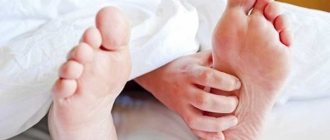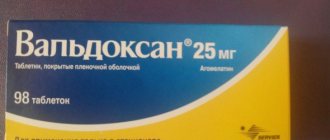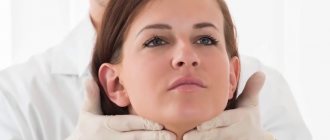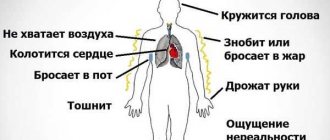Neuroses and neurosis-like conditions
A nervous disorder or neurosis is a consequence of psychological trauma resulting from severe fright, fear or a protracted traumatic situation. Neurotic disorders can manifest themselves in different ways, for example, obsessive actions (finger sucking, nail biting, etc.), tics, stuttering, enuresis. With neurosis, there are usually three characteristic symptoms: low mood, sleep disturbance and appetite disturbances.
Nervous disorders can be divided into three degrees:
• short-term neurotic reaction (lasts from several minutes to several days);
• neurotic state (lasts several months);
• neurotic personality development (temporary neurosis develops into chronic and distorts personality development).
Prerequisites and causes of neuroses in children
The first thing I would like to draw your attention to is that there are certain age periods characterized by increased vulnerability of the nervous system, these are 2 - 3 years (the crisis of 3 years, in which the child enters into a “fight” with his parents) and 5 - 7 years, when the child takes traumatic situations especially close to his heart, but still does not know how to influence them and does not have psychological protection.
In addition, different children are susceptible to neuroses to varying degrees. Children who have the following characteristics of character, nervous system and health are most prone to nervous disorders:
• increased: vulnerability, shyness, impressionability, dependence, suggestibility, irritability, excitability, anxiety, hyperactivity;
• increased desire for primacy, the desire to always be better than others.
- excessive demands from parents for the child, formal relationships in the family, suppression of the child’s initiative, excessive guardianship, authoritarian upbringing; - inconsistency in education; lack of a unified parenting style, inconsistency of views on education between parents; - “intimidating” parenting, in which the child is constantly frightened (“If you don’t sleep, Baba Yaga will fly in and take you away”) or “anxious” parenting, in which parents are constantly worried about the child (“Don’t pick up a knife, you’ll cut yourself” ).
Also important for the occurrence of neurosis are:
Biological factors (features of the psyche and physiology of the child): heredity, temperament (strong or easily excitable type of nervous system), previous diseases, general physical health, course of the mother’s pregnancy and childbirth, gender and age, body type, etc.
Generally debilitating factors: chronic lack of sleep, physical and mental overload (all kinds of clubs and sections), acute and chronic diseases.
There are three main forms of neurosis:
1. Neurasthenia (asthenic neurosis)
If a child is suspicious, timid, irritable, does not tolerate any mental stress well, and is often sick, then he has a predisposition to developing neurasthenia.
Asthenic neurosis occurs against the background of general weakness of the child (fatigue, dizziness, headaches, gastrointestinal disorders), sleep disturbances, autonomic disorders (pain in the heart, cold hands and feet, sweating, sensations that “something is compressing inside "). With anxiety or physical exertion, these disorders intensify. Often occur after infectious diseases, prolonged stress or a traumatic situation, lack of sleep, overwork, excessive mental or physical overload.
A child with neurasthenia comes into conflict with himself: “I want,” but “I cannot.” He becomes irritable, gets upset easily and cries. His behavior is often unpredictable: sometimes he is cowardly, sometimes desperately determined, sometimes he takes on an impossible task, sometimes he gives in to a simple task.
Often neurasthenia occurs against the background of excessive demands from parents, their inability to accept the child for who he really is. At the same time, the child, constantly feeling these high expectations (must be the smartest in the class, speak English like a native, etc.), begins to feel “inferior” and experiences chronic nervous tension, as a result of which neurasthenia develops.
Another cause of neurasthenia may be the parents' attention switching to another child who has appeared in the family. The older child, having lost parental attention, experiencing jealousy and acquiring new responsibilities (helping to care for the baby), begins to suffer from nervous breakdowns.
If a child is selfish, capricious, “demonstrative”, loves attention, childish, dependent, easily suggestible, capricious and often dissatisfied with everything, throws tantrums (rolling on the floor, stomping his feet, throwing things), then there is a high probability that he will be susceptible to hysteria. depression or hysterical attacks.
The internal conflict of such a child lies in the infringement of his egoistic position “I want/I don’t want”, in which resentment and dissatisfaction arise. The child does not yet know how to defend his interests, so he achieves his goals in ways accessible to him.
For example, in the first two years after birth, the child was allowed everything, but after two years the parents introduced strict restrictions. Another option: parents adhere to one position in education (strictness and all kinds of restrictions), and grandparents adhere to the opposite (permissiveness).
Hysterical neurosis can also develop due to a lack of basic attention to the child. And as attention deficit accumulates, the child makes demonstrations - he falls into hysterics, hits his head or, as we have already said, gets sick (fever, vomiting, etc.). By doing this, he attracts attention to himself, showing his experiences and suffering.
3. Obsessive-compulsive disorder
If a child is unsure of himself, fearful, overly cautious, anxious and suspicious, and, at the same time, pedantic, principled, meticulous and reasonable, then there is a possibility that, due to chronic traumatization of the psyche (when every now and then needs and desires) children come into conflict with the “should” attitude), obsessive-compulsive neurosis will develop.
This neurosis is characterized by involuntary, obsessive experiences and fears. As a concomitant symptom, nervous tics may appear - monotonous movements (blinking, wrinkling the forehead, shrugging, coughing) - or monotonous actions (frequently washing hands, pinching a pillow), which have a protective and soothing function and relieve nervous tension.
The roots of this neurosis are disturbances in family relationships (increased demands and integrity of parents, excessive severity and authoritarianism).
How to deal with childhood neurosis
Neurosis is easier to prevent than to treat.
Neuroses are psychogenic diseases; they are generated not by organic disorders, but by disharmony in interpersonal relationships, therefore the leading role in this situation belongs to the psychologist.
And the main way to treat neurosis is to identify, eliminate or mitigate the causes of stress. Sedative (calming therapy) is only an assistant.
It is necessary to change the parenting style, strengthen the child's character, and develop his emotional sphere. A psychologist or psychotherapist will help calm the child, instill confidence in him, and help him relive the trauma (if it is not too painful for the child) in order to clarify and work through it.
Neurosis-like conditions in children most often occur between the ages of 2 and 7 years. Unlike neuroses, there is no psychotraumatic factor in the origin of such disorders. The pathology is organic in nature and is often associated with disorders of the brain. Some diseases of the internal organs can contribute to the onset of a neurosis-like state.
The occurrence of pathological conditions in children can be caused by a disruption of the process of intrauterine development, congenital childhood nervousness (neuropathy), allergic diseases, etc. The disorder can occur against the background of previous diseases, head injuries, and toxic factors. Congenital factors, heredity, parental alcoholism, etc. play a big role.
Neurosis-like conditions in children are often manifested by hyperactivity with motor disinhibition syndrome, the presence of fears and nightmares, depression, tearfulness, dissatisfaction, aggressiveness, etc.
Children are in a state of anxiety, restlessness, become fearful, and complain of fatigue. Frequent accompaniments of the disease are nervous vomiting with refusal to eat (anorexia), bedwetting, stuttering, tics, fears, etc. The pathology is characterized by a slow or increased heart rate, nausea and vomiting, dry skin or increased sweating, stool retention or diarrhea and other painful manifestations.
Diagnosis and treatment
The main diagnostic signs on the basis of which a neurosis-like state can be distinguished from neurosis are the lack of connection between the disease and psychotraumatic situations, as well as the lower effectiveness of psychotherapy. When the cause of NS is identified and eliminated, the patient’s health is gradually restored. Drug treatment in combination with psychological help, physiotherapy and the creation of a calm home environment with a friendly attitude towards the child guarantees a favorable outcome.
39frspb.caduk.ru
Neuroses and neurosis-like conditions
Neuroses are reversible (functional) neuropsychic disorders, characterized by specific emotional-affective and neurovegetative-somatic disorders, intact criticism and the absence of psychotic phenomena. Essentially, this is a pathological, most often selective, reaction of the individual to disturbances in micro-social and psychological relationships with other people. The term “neurosis” was first used by the Scottish physician Gullen at the end of the 18th century (1776) to refer to disorders that “are not accompanied by fever...
Classification. Many different classifications of neuroses have been proposed. According to the International Statistical Classification of Diseases, Injuries and Causes of Death, Ninth Revision (1975), the following forms of neuroses are distinguished: neurasthenia, hysterical neurosis, obsessional neurosis, neurotic phobias, anxiety neurosis, hypochondriacal neurosis, neurotic depression, etc. Most convenient for clinical practice seems to divide neuroses into general ones, which include neurasthenia, hysteria and obsessive neurosis...
A person deprived of any neurotic traits under the influence of excessive neuropsychic overload may experience neurasthenic disorders or a reactive state, but without certain constitutional (premorbid) personality characteristics, types of neuroses such as hysteria, obsessive-compulsive neurosis, motor and autonomic neuroses usually do not develop. . Risk factors for neuroses include physical stress, somatic illnesses, injuries, family troubles,…
Neurasthenia (Greek neuron-nerve, asthenia - weakness, impotence) - nervous exhaustion, overwork. It manifests itself as a combination of increased excitability and fatigue. Characterized by inadequate reactions to minor troubles and the inability to suppress them, that is, disorders relate primarily to the sphere of emotions. Anything can be annoying: bright light, loud conversation, radio on, etc., and this often serves as a reason for another conflict...
Increased emotionality also affects all judgments and assessments - they are extremely unstable and changeable (affective logic). A frequent symptom of hysteria is pseudo-organic sensorimotor disturbances: hemitic or amputation-type anesthesia (not corresponding to the anatomical laws of distribution of sensitivity), paralysis or paresis (without symptoms of central or flaccid paralysis), astasia-abasia - the inability to stand and walk (without paresis...
Motor neurosis is manifested by local motor disorders - tics, stuttering, professional cramps such as writer's cramp, etc. They usually occur against the background of other neurasthenic disorders - increased irritability, fatigue, headaches, poor sleep, etc. Autonomic neurosis (vegetative dystonia ) - more or less selective dysfunction of internal organs. The most common dysfunction is the cardiovascular, respiratory…
Functional psychosomatic disorders developed as a consequence of constitutional characteristics and systematic neuropsychic overstrain. The effectiveness of lifestyle improvement has been shown. Neurosis-like conditions (neurosis syndrome) include transient, mainly neurasthenic, disorders caused by organic lesions of the brain (initial manifestations of insufficient blood supply to the brain, dyscirculatory encephalopathy, stroke, encephalitis, meningitis, etc.), general somatic diseases, infections, intoxications and injuries. All neuropsychic and vegetative...
The main methods of treating neuroses and neurosis-like conditions are psychotherapy (individual and group), rest, exclusion from the environment that provoked the disease, as well as restorative and psychotropic drugs. Depending on the form and severity of the neurosis, they are used in various combinations. For patients with relatively moderate hypersthenic and vegetative-vascular manifestations, milder sedatives are indicated - valerian, motherwort, passionflower, bromides or...
It is always important, during a conversation with a patient, to reveal the cause that is traumatic to the patient’s neuropsychic sphere and try to eliminate it, or, using various methods of psychotherapy, reduce its significance. In cases of neurasthenia, obsessional neurosis, vegetoneurosis and neurosis-like conditions, the method of rational psychotherapy (or persuasion psychotherapy) is used primarily; in those suffering from hysteria and motor neuroses, the method of suggestion is used both in the waking state,...
Possible complications from the use of tranquilizers - drowsiness, decreased psycho-emotional tone and memory (short-term), decreased speed of motor reactions, arterial hypotension, ataxia, impaired potency and sphincter function, nystagmus, double vision, dysarthria - from the use of antipsychotics - early and late extrapyramidal disorders (lingually -buccofacial dyskinesias, choreoathetoid hyperkinesis, parkinsonism) and vegetative-endocrine disorders (weight gain, amenorrhea, arterial hypotension, hyperglycemia, hypothermia or hyperthermia, ...
The prognosis depends on the form of neurosis and the age of the patients. It is more favorable for neurasthenia, vegetative neurosis and neurosis-like conditions (if the latter are not caused by a severe and prolonged somatic illness). Hysteria, obsessive-compulsive neurosis and motor neuroses are more difficult to treat. However, with age, many emotional, affective and phobic disorders usually smooth out. Most patients with neurosis can be treated on an outpatient basis with follow-up...
www.medkursor.ru
Therapy
Treatment uses methods that influence the physiological causes of incontinence (diuretics, antispasmodics, physiotherapy, special nutrition) and the state of the patient’s nervous system (sedatives, psychotherapy).
Medicines
The following groups of drugs are used in the treatment of urinary incontinence:
- M-anticholinergics. The drugs relax smooth muscles, relieve spasms that lead to urination, and increase the reservoir capacity of the bladder. The most effective anticholinergics are Oxybutin and Driptan. Atropine can be used to relieve bedwetting.
- Synthetic analogues of vasopressin. The substance is a natural diuretic that regulates the excretion and reabsorption of water. Its substitutes (Desmopressin, Adiucretin) are used to reduce the volume of urine that is excreted during sleep (with nocturnal enuresis).
- Nootropics. Drugs (Piracetam, Picamilon, Glycine, Pantogam) are prescribed to improve cerebral microcirculation, correct the regimen (when using drugs with a stimulating and sedative effect) and treat sleep disorders associated with rapid falling asleep and profundosomnia.
- Herbal medicines with a sedative effect. For neurotic urinary incontinence, natural sedatives based on valerian, motherwort, and lemon balm are prescribed . Herbal infusions are accepted for 6-12 months.
- Vitamin and mineral complexes.
To treat enuresis in neurosis, tranquilizers (Radedorm, Rudotel, Eunoctine) and antidepressants (Melipramine, Amitriptyline) are also used.
When diagnosing the cause of incontinence, it is important to exclude inflammatory processes in the genitourinary system. If the results of urine microscopy, bacterial culture or PCR tests show signs of infection, the patient is also prescribed antimicrobial agents. The most preferred ones include fluoroquinolones, nitrofurans, macrolides and cephalosporins. In case of viral etiology of inflammation, immunomodulatory (Genferon, Viferon) and antiviral agents are prescribed.
Psychotherapy
Patients who suffer from neurosis-like enuresis are advised to undergo psychotherapy. It allows you to identify the root cause of a neurotic disorder or chronic stress and correct the condition.
If urinary incontinence is caused by problems in the family, individual psychotherapy will have low effectiveness. For comprehensive treatment, family psychological consultation is necessary. Hypnosis and self-hypnosis techniques can also be used.
Alternative Methods
In addition to psychotherapy and medication, the following methods of treating enuresis are used:
- Monitoring urination using an enuresis alarm. This device detects the humidity of linen or bed and wakes up the patient with a sound and vibration signal, forming a wake-up reflex when the urge occurs. For neurosis-like enuresis, the alarm clock should be used only in combination with psychotherapy and sedatives.
- Diet. A decrease in the volume of fluid consumed and an increase in salt content in the evening causes fluid retention in the body. Dietary therapy is a narrowly applicable practice (helps only symptomatically and only with nocturnal enuresis) and can cause inconvenience to the patient.
- Physiotherapy. Exercise therapy serves to strengthen the pelvic floor muscles and improve urinary sphincter control. Therapeutic exercises can be used for polyetiological enuresis and as an additional therapy for incontinence in girls and women.
- Physiotherapy. The list of the most effective physiotherapeutic methods for enuresis includes electrophoresis, high-frequency current therapy (darsonvalization), magnetic therapy, acupuncture, restorative massage, and electrosleep.
Adult patients are able to independently develop self-control, attend psychotherapy sessions and correct the condition with medications, but treatment of neurological enuresis in children depends entirely on parents . They should be patient and not express negative emotions directly towards the child, as this may only prolong the therapy. On average, treatment of enuresis takes up to several months.
Advertising:
Neurotic neurosis-like syndrome: treatment, symptoms in humans
The problem of neuroses has recently become extremely relevant. According to official WHO data, their number has increased more than 24 times over the past 65 years. During the same period, the number of mental illnesses increased by only 1.6 times. Massive studies have revealed the presence of various forms that a neurotic, neurosis-like syndrome can take, treatment, the symptoms of which we will now consider.
Basic neurosis-like human conditions
There are asthenic, obsessive, hypochondriacal, hysterical syndromes. Each of them has its own significant differences, which we will try to understand:
This neurotic syndrome develops gradually, going through stages of development. At the very beginning of the onset of the disorder, increased fatigue and a feeling of tiredness occur. A person often feels nervous and becomes emotionally unstable. Next, irritability begins to quickly give way to passivity, apathy, and indifference to what is happening. Subsequently, a distorted perception of the world, events occurring around, and the surrounding reality arises. Symptoms of asthenic syndrome are also a reaction of violent irritation to bright light, loud sounds, strong smells and touch.
This condition is also characterized by daytime drowsiness, followed by lack of sleep at night, increased sweating, frequent headaches, heart pain, and constant anxiety. It is with this syndrome that most mental illnesses usually begin.
This syndrome is characterized by obsessive states. A person develops obsessive thoughts, fears, strange rituals and inclinations. Motor reactions appear that do not depend on the will of the person. At the same time, the patient realizes the absurdity of his actions, is deeply worried about this, but cannot get rid of them on his own. It happens that with a great effort of will a person can temporarily get rid of obsessive states, but most often they return again and the patient is forced to seek help from a doctor. This state of obsessive ideas, thoughts and actions is often found in neuroses, psychopathy, schizophrenia, as well as severe depression and prolonged experiences.
This condition is characterized by a painful fear for one’s health. A person is very afraid of becoming seriously ill, and this fear haunts him, haunts him day and night. The initial cause of this condition is pain or some kind of unpleasant sensation in the internal organs or other parts of the body. It seems to a person that something is squeezing, tingling, tickling, itching, etc. A patient with a similar symptom begins to visit various specialists, complaining about an imaginary disease and demanding that it be detected and cured. Moreover, even a thorough medical examination, which confirmed that there are no diseases, does not satisfy him. They begin to accuse doctors of inattention and lack of competence and look for another specialist.
People suffering from this syndrome are convinced that they are the source of a dangerous disease or epidemic, or insist that they have been damaged or cursed by a witchcraft. Hypochondriacal neurosis-like syndrome often accompanies low-grade schizophrenia, psychopathy and depressive states.
This pathology manifests itself in violent emotions, demonstrative behavior, and hysteria. A person’s actions, facial expressions, words, and gestures are accompanied by violent emotions, tears (laughter), and screaming. With the next hysteria, a person wrings his hands, tears out his hair, and often faints. Moreover, unlike a real hysterical attack, these patients pretend to have a seizure. They defiantly slide to the floor, supposedly trying to stop themselves from falling, or pretend to faint. All this is accompanied by loud screams, convulsions, groans, and loud crying.
Sometimes it is possible to develop functional paralysis, paresis. Partial or complete blindness or deafness may occur. It is clear that a person’s neurotic conditions need to be treated.
As a rule, people who already have pronounced disorders turn to psychiatrists and neurologists. Therefore, experts consider it very important to carry out work on early diagnosis of neuroses and rehabilitation of patients, in order to reduce the degree of painful disorders. In this case, the most effective treatment method is psychotherapy. It is very important for effective treatment to exclude the traumatic situation that caused the onset of neurosis. If this is not possible, the doctor will help restructure the person’s attitude towards the existing situation.
Having noticed more severe symptoms in a person, doctors also use drug treatment:
In the presence of phobias, tranquilizers are used - Elenium, Tazepam. If depression is present, antidepressants are prescribed. For anxiety forms, Amitriptyline is used. In the presence of apathetic and asthenic conditions, Melipramine is usually prescribed. Hypochondriacal disorders are treated with Teralen, Thioridazine.
If necessary, complex therapy includes drugs to reduce vestibular excitability, antiepileptic and dehydration drugs.
The dosage of medications must be sufficient and must be selected strictly individually. The drugs are dispensed only with a prescription from the attending physician.
www.rasteniya-lecarstvennie.ru
Clinical picture of neurosis-like syndrome
Symptoms of the disease are distinguished by a variety of clinical manifestations. Among them are:
- Violation of human behavior with severe short temper, mood swings over a short period.
- Character change. With an initially friendly and calm disposition, the patient becomes easily excitable, displays dissatisfaction and aggression.
- Sleep disorders with constant lack of sleep, frequent awakenings.
- Vomiting that occurs due to stress.
- Gastrointestinal disorders with diarrhea or constipation.
- Decreased or complete absence of appetite before the development of an anorexic state.
- Clinic of vegetative-vascular disorders with headaches, fluctuations in blood pressure, and cerebral vascular spasms. Symptoms may appear separately.
Neurosis-like syndrome is a collective concept that includes several types of mental disorders. Each of the disorders has its own clinical symptoms and characteristics. Among the main syndromes are:
- Asthenic. In the initial stages of its course, the patient notes irritability to everything that happens. In the future, this condition will be replaced by increased fatigue, general malaise, constant drowsiness, decreased memory and intolerance to physical activity. A person becomes indifferent to everything that happens in society and close surroundings. Headaches and increased sweating also appear.
- Obsessive-compulsive. The patient notes the development of a tendency to perform certain rituals. Obsessive movements arise that a person cannot control.
- Hypochondriacal. In this case, a person is looking for diseases in himself. He turns to specialists with various complaints, but diagnostic methods do not reveal any violations. In addition, a neurotic person tries to heal on his own, which can cause health problems. In some cases, patients invent diseases for themselves, explaining it as damage or the evil eye.
- Hysterical. The development of the syndrome is characterized by demonstrative behavior with bright gestures and commentary on what is happening. People with this disorder may fall to the floor, hit their heads, and tear out clumps of their hair.
- Neurosis-like hyperkinetic syndrome. Parents turn to specialists with complaints about their children’s poor perseverance, difficulty perceiving information, as well as emotional disorders in the form of aggressiveness, short temper or excessive tearfulness. What neurosis-like hyperkinetic syndrome in children is can be understood quite easily. Therefore, this form does not cause difficulties in making a diagnosis.
neurotic and neurosis-like syndromes
Category: Psychiatric Nursing/Clinical manifestations of major psychopathological syndromes
This group includes asthenic syndrome, obsessional syndromes (obsessive, phobic), hypochondriacal and hysterical syndromes
.
Asthenic syndrome
-
a state of neuropsychic weakness.
It develops gradually, little by little . At first, most often there is increased fatigue, emotional instability, irritability, exhaustion of attention and, as a result, decreased ability to work. Subsequently, passivity, indifference, and unclear perception of the environment may occur.
Patients with asthenic syndrome cannot tolerate bright light, loud sounds, strong odors, or touches. They experience constant drowsiness during the day, which may be accompanied by persistent insomnia at night. Excessive sweating, headaches at the end of the working day or in the morning, discomfort in the heart area, and a feeling of tension are of concern. Patients do not tolerate changing weather well.
All mental illnesses begin with asthenic syndrome, it accompanies any somatic diseases, and can be observed during the recovery period from severe infectious diseases. Asthenic syndrome is the essence of asthenic neurosis (neurasthenia).
Obsessive syndrome
-
includes symptoms in which obsessive thoughts, doubts, memories, rituals, drives, and motor acts come to the fore
. The patient critically evaluates the absurdity of his experiences, but is often unable to overcome them, and asks the doctor to help him. Sometimes, at the cost of great effort, he manages to temporarily get rid of the painful condition or reduce its severity.
Phobic syndrome
-
manifests itself in a variety of obsessive fears
. Nosophobia - fear of contracting some disease; claustrophobia - fear of enclosed spaces; Agarophobia - fear of open spaces; thanatophobia - fear of death. These fears are usually introduced into the minds of patients, despite the obvious absurdity, and continue to exist, despite all attempts to get rid of them.
Various types of obsessions occur in neuroses, psychopathy, schizophrenia and emotional stress conditions.
.
Hypochondriacal syndrome
-
manifested by the patient’s constant fear for his health, the conviction of the presence of a serious, incurable disease
.
This extremely painful condition is caused by unpleasant sensations from various organs or individual parts of the body. Then a hypochondriacal overvalued idea is formed. Patients often turn to various doctors, requiring in-depth medical examinations, but usually no somatic pathology is detected in them. Later, patients, having not received help, accuse doctors of hostility and even sabotage, consider themselves sources of dangerous infections, and claim that they have been bewitched and hypnotized. Hypochondriacal syndrome occurs in low-grade schizophrenia, psychopathy, and depressive states
.
Hysterical syndromes
-
varied in their manifestations.
They represent an individual combination of five main components: mental, vegetative-visceral, motor, sensory and speech disorders . Hysterical symptoms are characterized by egocentrism, situational dependence of the appearance and degree of severity, apparent deliberateness, demonstrativeness, greater suggestibility and self-hypnosis of patients, the ability to derive any benefit from their painful state, which is not realized by the patients.
Hysterical syndromes occur in neuroses, psychopathy
.
- Nurse's Handbook for Care/N. I. Belova, B. A. Berenbein, D. A. Velikoretsky and others; Ed. N. R. Paleeva. - M.: Medicine, 1989.
- Bortnikova S. M., Zubakhina T. V. Nervous and mental illnesses. Series 'Medicine for you'. Rostov n/d: Phoenix, 2000.
- Kirpichenko A. A. Psychiatry: Textbook. for honey Inst. — 2nd ed., revised. and additional — Mn.: Vysh. school, 1989.
m-sestra.ru
What is neurosis-like syndrome: types, symptoms and treatment
Most modern people know this condition as neurosis. It is often caused by a large amount of stress in a person’s life, and manifests itself in irritability, fatigue, and lethargy.
In some cases, such symptoms may occur on their own, without the presence of stressful situations. In such a situation, the symptoms are caused by existing or past diseases of the internal organs, nervous and endocrine systems.
Neurosis-like conditions are neuropsychic diseases that are similar in manifestations to neuroses, but do not arise due to stress or psychological factors. Experts are inclined to believe that this is an organic pathology.
Causes
The cause of neurosis-like enuresis can be a psychological trigger (irritant) or chronic stress . In children under 12 years of age, the cause of incontinence is often profundosomnia, a sleep disorder that is expressed by prolongation of the phase of very deep sleep and the patient’s lack of response to signals from the urinary centers in the central nervous system.
Risk factors for developing urinary incontinence are:
Advertising:
- hereditary predisposition to this syndrome (the disorder was diagnosed in childhood or adulthood in at least one of the parents);
- delayed development of urination centers in children;
- hormonal imbalances and endocrine diseases;
- age-related changes in brain tissue;
- pathologies of the genitourinary system.
The following phenomena can be psychological causes of enuresis:
- social disadvantage of the family;
- family quarrels;
- accidents, long hospital stays;
- stress from moving, changing jobs, living conditions;
- physical punishment, domestic violence;
- phobias and fear (for example, when attacked by dogs);
- post-traumatic shock;
- stressful situation in a work or educational team.
In children, among other factors, the onset of pathology can be triggered by divorce or loss of parental attention (for example, at the birth of a brother or sister).
Psychosomatics plays a key role in the development of neurosis-like enuresis, so the choice of therapy is determined, first of all, by the psychological root cause of the disorder.
Types of neurosis-like conditions
Asthenic syndrome
This syndrome does not occur suddenly, but progresses gradually. At first, the manifestations are expressed in fatigue and a feeling of tiredness, emotional instability and increased nervousness.
Then irritability disappears and is replaced by inactivity and apathy. At the same time, a person also develops indifference and an incorrect perception of the environment, a distorted assessment of events.
Patients find it difficult to tolerate loud and sharp sounds, touches, bright lights, and smells. Also characteristic features are nighttime insomnia and daytime sleepiness, excessive sweating, constant attacks of headaches, heart pain, a constant feeling of tension and anxiety. The patient's condition becomes worse with changing weather and climatic conditions.
This syndrome is often the onset of many mental illnesses, but can also be observed during treatment for somatic and infectious diseases.
Obsessive-compulsive syndrome
The name itself suggests that it is associated with obsessive states. The patient may be subject to obsessive thoughts, fears, addictions, strange rituals, and uncontrolled movements.
The patient understands the absurdity of his conditions and experiences, but cannot cope with them on his own. In some cases, it is possible to get rid of obsessions with the help of self-control, but often these conditions return again and seeking medical help cannot be avoided.
Obsessive ideas are often a symptom of neuroses, psychopathy, schizophrenia, and severe depression.
Hysterical syndrome
With this syndrome, the patient exhibits demonstrative behavior and violent emotional manifestations. All the patient’s actions, his facial expressions, speech, gestures, go along with extremely violent emotions, crying, laughing, screaming, wringing of hands, fainting, etc.
This condition should not be confused with a real hysterical attack, since with hysterical syndrome the patient pretends to have a seizure, his actions are demonstrative.
There is a possibility of developing paresis, functional paralysis, partial or complete blindness, and deafness.
Hypochondriacal syndrome
With this syndrome, the patient develops persistent painful fear for his health, fear of serious illnesses. Such fear does not leave the patient, depending on the time of day or the surrounding reality.
Initially, the impetus for such fears is pain or discomfort in the body. The patient begins to look for manifestations of various diseases, feel specific symptoms, visit various specialists, demanding to diagnose and cure his disease.
Complex of reasons
Neurosis-like syndrome often appears in childhood. The cause may be prenatal developmental disorders, illnesses and injuries suffered at an early age. When the disease appears at a later age, the reasons may be different.
The most common are the following:
These conditions appear as a result of abnormalities in the functioning of the hypothalamic-limbic structures of the brain (caused by the above diseases), and as a result, a disorder of the neurodynamics of the cerebral cortex develops.
Children's reasons
In children, a neurosis-like syndrome begins to manifest itself in the age range from 2 to 7 years.
The appearance of the syndrome in childhood can occur for various reasons. These include:
- pathologies of intrauterine development, negative influences during pregnancy (alcohol, drugs, smoking);
- diseases of the nervous system of various origins (infectious, traumatic);
- somatic disorders (chronic infectious inflammation, diseases of the gastrointestinal tract, cardiovascular system);
- hereditary pathologies of various parts of the brain.
Features of the disease
As a medical term, enuresis means any systematic involuntary urination in patients over 5 years of age. In children younger than this age, the nervous system is not mature enough to fully control physiological functions. The urinary disorder becomes clinically significant no earlier than 5-6 years.
In ICD-10, enuresis is listed under the number F98.0 and refers to a group of emotional and behavioral disorders that usually begin in childhood and adolescence.
At the age of 5, enuresis is diagnosed in 15-20% of children. Children one year older suffer from this disease less often - in 7-12% of cases. In the age group of 6-12 years, involuntary urination is observed in 3 children out of 100, and in 12-18 years - in one. In adults, the pathology is even less common - in about 1 person in 200. If enuresis was diagnosed in childhood, the risk of developing pathology in adulthood increases.
Most often, the problem manifests itself at night, but in 10-15% of cases, patients are diagnosed with daytime and mixed enuresis. Involuntary urination during the day is highly likely to be associated with neurosis or stress.
A number of specialists in urology and psychiatry also classify pathology by the nature of the patient’s attitude towards episodes of urinary incontinence. Neurosis-like enuresis is characterized by long-term indifference of patients to their condition (mainly pre-pubertal children) and increased experiences afterwards. Neurotic enuresis is characterized by initial psychological discomfort and stress.
Regardless of the type of pathology, neurologists, psychiatrists, psychologists, urologists, physiotherapists, pediatricians or general practitioners should take part in the diagnosis of urinary incontinence. Treatment tactics depend on the etiology of the disease.
Features of symptoms
A neurosis-like condition in children can be suspected if the following symptoms are present:
In adults, the syndrome has the following symptoms:
Difference from neuroses
Neurosis-like conditions and neuroses have the same manifestations and symptoms. The difference between them lies in the nature of the appearance.
Neuroses appear as a result of prolonged stressful situations that deplete the nervous system, cause anxiety, and autonomic disorders. Neurosis-like conditions do not have psychological causes. They belong to organic diseases. Previously, they were called “organelles”.
The cause of such disorders is mild cerebral pathology caused by pathologies of intrauterine development, or resulting from previous diseases.











